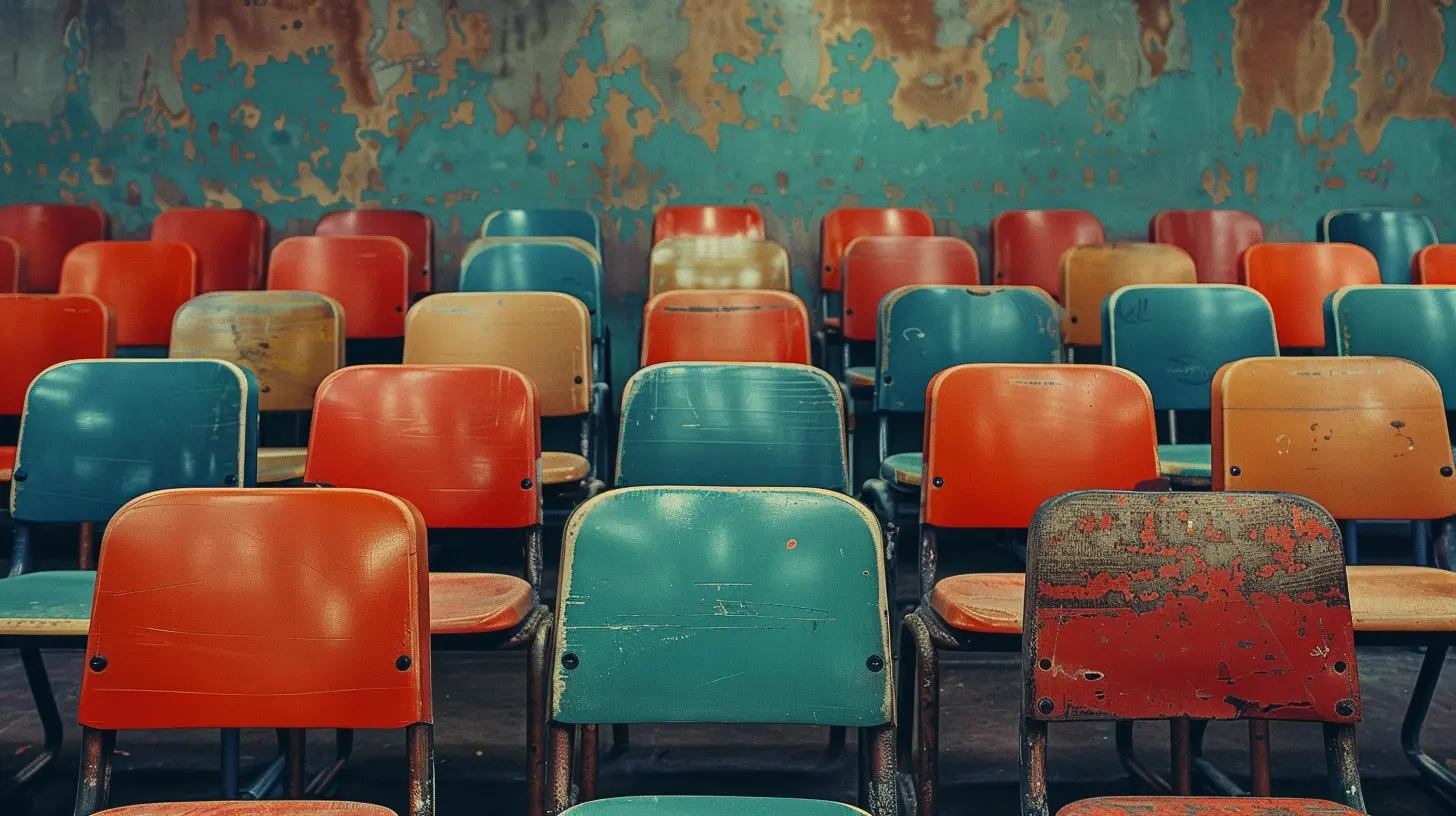Managing Classroom Chaos: Tips for High-Energy Classrooms
25 December 2024
Let’s be real for a second—managing a classroom full of high-energy students can feel a bit like trying to herd cats. One moment, everyone is seated and focused, and the next, you’ve got a juggling act of chatter, fidgeting, and maybe even a few paper airplanes flying around. Sound familiar? If you’re nodding your head right now, I’m here to reassure you that you’re not alone, and better yet, there are effective ways to manage all that classroom chaos.
In this article, we'll dive into some practical tips to help you channel that high energy into productive learning. Whether you're a new teacher or a seasoned pro, these strategies will help you bring structure to your classroom without putting a lid on students' enthusiasm.

1. Understand the Root Cause of the Chaos
Before we get into the nitty-gritty of managing chaos, let’s talk about the why. Why do kids act out or get overly excited in the first place? High-energy students often aren’t trying to be disruptive on purpose. Sometimes, it’s just that their energy levels are off the charts compared to others.Consider this: Some kids are natural movers and shakers—they just can’t sit still. Others might be bored or frustrated with the lesson. And then there are those who may simply crave attention, whether it’s from you or their peers.
When you understand the reasons behind the chaos, you can start to address the root causes rather than just the symptoms. It’s like fixing a leaky faucet—patching up the drip won’t do much if you don’t address the plumbing issue behind it.

2. Set Clear Expectations from Day One
Now, this may sound like a no-brainer, but you’d be surprised how many educators skip this crucial step. The first day of class is prime time to set the tone for the rest of the year. If your students don’t know what’s expected of them, you can bet chaos will ensue.Create a simple, easy-to-understand set of classroom rules. But here’s the catch—don’t just announce them and move on. Involve your students in the process. Why? Because when students feel like they have a say in creating classroom norms, they’re much more likely to follow them.
Pro Tip: Use a visual chart or poster that students can refer to throughout the year. You might even want to have them sign a “Classroom Contract” so they feel accountable for their behavior.

3. Embrace Positive Reinforcement
It’s easy to focus on the misbehavior, but what if you flipped the script? Positive reinforcement is like gold in a high-energy classroom. When you acknowledge good behavior, you’re more likely to see it repeated.Instead of saying, “Stop talking!” try something like, “I love how Sarah is sitting quietly and ready to learn.” This simple shift in language can work wonders. Kids will naturally gravitate toward receiving praise, and soon enough you'll see more students following suit.
You can also implement a reward system, like a points chart or “classroom currency” that students can trade in for small prizes or privileges. Just be sure to keep it fair and consistent, so it doesn’t become a source of competition or resentment.

4. Use Movement to Your Advantage
Here’s the thing: expecting high-energy students to sit still for long periods is like expecting a puppy not to wag its tail—it’s just not going to happen. Instead of fighting the fidgeting, use it to your advantage.Incorporate movement into your lessons. Brain breaks, stretch sessions, or even quick games can help burn off some of that excess energy while keeping students engaged. You can also try standing desks or flexible seating options, which allow students to move around while still staying focused on the task at hand.
Not only does movement help manage energy, but it’s also a great way to enhance learning. Studies show that physical activity boosts memory and cognitive function, so you’re hitting two birds with one stone!
5. Break Lessons into Bite-Sized Chunks
Ever notice how students start to zone out after about 15 minutes? That’s because attention spans—especially for younger kids—are limited.Instead of delivering long-winded lectures or instructions, break your lessons into smaller, digestible chunks. Focus on one key concept at a time, and then give students a quick break or activity before moving on to the next idea.
Think of it like a TV show with commercial breaks. Those little pauses give students a chance to reset and refocus, making it easier to absorb the information you're teaching.
6. Use Group Work Wisely
Group work can either be a lifesaver or a disaster, depending on how you manage it. In a high-energy classroom, group activities are a great way to let students collaborate and engage with the material in a hands-on way. But without the right structure, they can quickly spiral out of control.Here’s a tip: assign clear roles within groups. For example, one student could be the “timekeeper,” another the “note-taker,” and another the “presenter.” This not only keeps students on task, but it also gives them a sense of responsibility.
Make sure to rotate roles regularly, so everyone gets a chance to contribute in different ways. And don’t forget to check in with each group periodically—you want to guide them without hovering.
7. Implement Visual and Auditory Cues
Sometimes, managing chaos is as simple as giving students a non-verbal reminder to focus. Visual cues—like holding up a hand or flashing a light—can signal to students that it’s time to quiet down or pay attention.Similarly, auditory cues like a bell, chime, or even a short piece of calming music can cue transitions between activities. The key is consistency. Once students associate these cues with certain actions, you’ll find it much easier to manage transitions and keep the classroom running smoothly.
8. Keep Routines Consistent but Flexible
Even in the most energetic classrooms, kids find comfort in routine. When they know what to expect, they’re less likely to act out. Establish a daily or weekly routine that students can follow, from how the day starts to how it ends.But here’s a little caveat—while consistency is important, don’t be afraid to be flexible when needed. If you notice that an activity isn’t working or that students are particularly restless, it might be time to switch things up. Flexibility shows that you’re attuned to your students’ needs, and it can prevent small disruptions from snowballing into full-blown chaos.
9. Maintain a Calm and Collected Demeanor
Let’s be honest—when the classroom starts spiraling out of control, it’s easy to lose your cool. But here’s the thing: students feed off your energy. If you’re visibly stressed or frustrated, they’ll pick up on that and the chaos will only escalate.Instead, try to model the behavior you want to see. Stay calm, composed, and in control. It’s like being the eye of the storm—the calmer you are, the more likely your students will settle down.
If you need a moment to collect yourself, take it. Step aside, take a deep breath, and then return to the situation with a clear head. Your students will respect your ability to stay cool under pressure, and they’ll be more likely to follow your lead.
10. Build Relationships and Trust
At the end of the day, managing classroom chaos isn’t just about rules and routines—it’s about relationships. When students trust and respect you, they’re far more likely to listen and follow your guidance.Take the time to get to know your students individually. Show interest in their lives, listen to their concerns, and be approachable. When students feel seen and heard, they’re more likely to buy into your classroom management strategies.
Remember, it’s not about being their friend, but about building mutual respect. Once that foundation is in place, you’ll find that managing even the most high-energy classroom becomes much more manageable.
11. Be Proactive, Not Reactive
Finally, aim to be proactive rather than reactive when it comes to managing classroom chaos. This means anticipating potential challenges and addressing them before they escalate into bigger issues.For example, if you know that a particular student struggles with staying on task during independent work, offer them extra support or check in with them more frequently. If you notice that students tend to get restless after lunch, plan a more active lesson for that time of day.
By staying one step ahead, you can prevent chaos from taking over and keep your classroom running smoothly.
Final Thoughts
Managing a high-energy classroom doesn’t have to feel like a constant uphill battle. With the right strategies in place—and a little flexibility—you can turn that energy into a force for good. Remember, the goal isn’t to stifle your students’ enthusiasm but to guide it in a way that promotes learning and growth.So, the next time you find yourself amidst the chaos, take a deep breath, put these tips into action, and watch as your classroom transforms from a whirlwind into a well-oiled machine.
all images in this post were generated using AI tools
Category:
Classroom ManagementAuthor:

Eva Barker
Discussion
rate this article
19 comments
Quentin Kirkpatrick
This article offers valuable strategies for managing high-energy classrooms effectively. By incorporating structured activities and fostering student engagement, teachers can create a positive learning environment while channeling that energy productively. A must-read for educators!
March 30, 2025 at 6:51 PM

Eva Barker
Thank you for your kind words! I'm glad you found the strategies helpful for creating a positive learning environment in high-energy classrooms.
Melody McKeever
Embrace the energy! With the right strategies and creativity, you can transform classroom chaos into vibrant learning experiences that inspire and engage every student. Keep shining!
March 8, 2025 at 12:35 PM

Eva Barker
Thank you! Embracing energy can truly unlock creativity and engagement in the classroom. Let’s inspire our students together!
Tia Fields
Empower your students with structure and creativity—chaos can spark incredible learning and growth!
February 14, 2025 at 2:03 PM

Eva Barker
Thank you for your insightful comment! Striking a balance between structure and creativity is key to harnessing the energy in high-energy classrooms effectively.
Brigitte McGivern
Great tips! Managing high-energy classrooms can be a challenge, but with the right strategies, it’s definitely possible. Love the ideas shared here—definitely going to try a few!
February 2, 2025 at 1:28 PM

Eva Barker
Thank you! I'm glad you found the tips helpful. Good luck implementing them in your classroom!
Ariella Jackson
Great article! These practical tips for managing high-energy classrooms are essential for fostering a positive learning environment. Implementing structure and engaging activities truly makes a difference.
January 30, 2025 at 8:59 PM

Eva Barker
Thank you! I'm glad you found the tips helpful for creating a positive learning environment. Your feedback inspires me to share more practical strategies!
Shelby McGuffin
Great article! Managing high-energy classrooms can be challenging, but your practical tips on establishing routines and maintaining engagement are spot on. I especially appreciate the emphasis on positive reinforcement and clear expectations. These strategies can make a significant difference in creating a productive learning environment. Thanks for sharing!
January 27, 2025 at 12:45 PM

Eva Barker
Thank you for your feedback! I'm glad you found the tips helpful for creating a positive and productive learning environment.
Elena O'Brien
Your insights truly resonate—thanks for sharing!
January 23, 2025 at 1:33 PM

Eva Barker
Thank you! I'm glad you found the insights helpful!
Idris Collins
In high-energy classrooms, structure and flexibility are key. Establishing clear routines fosters a sense of security, while allowing for spontaneous moments encourages creativity. Remember, embracing the chaos with patience and positivity can transform a bustling classroom into a vibrant space for learning and growth.
January 17, 2025 at 12:06 PM

Eva Barker
Thank you for highlighting the balance between structure and flexibility! Creating clear routines while embracing spontaneity is essential for a dynamic learning environment. Your insights truly capture the essence of managing high-energy classrooms effectively.
Eden Lewis
Thank you for sharing these fantastic tips! Managing high-energy classrooms can be a challenge, but your insights will surely help educators create a more focused and engaging learning environment. Keep up the great work!
January 15, 2025 at 5:36 AM

Eva Barker
Thank you for your kind words! I'm glad you found the tips helpful. Here's to creating more engaging classrooms!
Hugo McGinn
This article offers practical advice for educators navigating high-energy classrooms. I appreciate the emphasis on proactive strategies and building relationships with students, which are essential for fostering a positive learning environment amidst the chaos. Great insights!
January 10, 2025 at 9:16 PM

Eva Barker
Thank you for your thoughtful feedback! I'm glad you found the tips on proactive strategies and relationship-building valuable for managing high-energy classrooms.
Raegan Perez
Great tips! Incorporating structured routines and engaging activities can significantly enhance classroom management. Thanks!
January 3, 2025 at 9:50 PM

Eva Barker
Thank you! I'm glad you found the tips helpful for enhancing classroom management!
Simone Wolf
While the article offers practical strategies for high-energy classrooms, it could delve deeper into the underlying psychological factors driving student behavior. Understanding these motivations might enhance the effectiveness of the suggested techniques and promote a more harmonious learning environment.
December 30, 2024 at 12:57 PM

Eva Barker
Thank you for your insightful feedback! I agree that exploring the psychological factors behind student behavior could enrich the discussion and improve our strategies for managing energetic classrooms. Your suggestion is appreciated!
Cynthia Thomas
This article offers practical insights for educators navigating the challenges of high-energy classrooms. The strategies presented not only promote effective classroom management but also create an engaging learning environment. I appreciate the emphasis on maintaining a positive atmosphere while fostering student participation. Thank you for sharing these valuable tips!
December 29, 2024 at 8:30 PM

Eva Barker
Thank you for your thoughtful feedback! I'm glad you found the strategies helpful for fostering engagement and positivity in high-energy classrooms.
Jack Bellamy
“Ah, managing high-energy classrooms! Because who doesn’t love playing referee to a mini Olympics, right? Forget teaching strategies; just hand out capes and let the kids fly! With these tips, you’ll be the proud captain of the good ship Chaos—good luck navigating those stormy seas!”
December 29, 2024 at 1:06 PM

Eva Barker
Thanks for the fun analogy! Embracing the energy can definitely turn chaos into creativity. Here’s to navigating those seas with a sense of humor!
Landon Foster
Great tips on harnessing high energy in the classroom! Implementing clear routines, engaging activities, and positive reinforcement can transform chaos into a dynamic learning environment. Consistency and enthusiasm are key to student engagement and success!
December 28, 2024 at 12:51 PM

Eva Barker
Thank you for your thoughtful comment! I completely agree—consistency and enthusiasm are essential for creating an engaging learning environment.
Betsy Roberts
Effective classroom management in high-energy environments requires clear expectations, consistent routines, and engaging activities to channel student energy into productive learning experiences.
December 26, 2024 at 1:47 PM

Eva Barker
Thank you for your insightful comment! I completely agree—strong expectations and engaging activities are key to harnessing that energy for productive learning.
Davina Whitley
Great tips for harnessing energy in the classroom! Practical strategies can transform chaos into engaging learning experiences.
December 25, 2024 at 8:15 PM

Eva Barker
Thank you! I'm glad you found the tips helpful for creating engaging learning environments.
Thorne Lambert
Great insights! Implementing these tips can truly transform high-energy classrooms into engaging learning environments. Keep inspiring!
December 25, 2024 at 1:38 PM

Eva Barker
Thank you! I'm glad you found the tips helpful. Engaging high-energy classrooms can really make a difference!
Sylvan Lee
In high-energy classrooms, chaos often masks creativity. By embracing structured spontaneity and fostering emotional intelligence, educators can harness student energy, transforming it into a dynamic learning environment. Ultimately, it’s about guiding the whirlwind, allowing authentic connections and insights to flourish amidst the storm.
December 25, 2024 at 5:25 AM

Eva Barker
Thank you for your insightful comment! Embracing structured spontaneity and emotional intelligence truly is key to transforming high-energy chaos into a vibrant learning environment. Your perspective highlights the importance of guiding student energy for meaningful connections and creativity.
MORE POSTS

How to Cultivate a Love for Music in Your Children

How to Tackle Homework in Subjects You Don’t Enjoy

How to Use Educational Psychology to Improve Homework Practices

Lesson Planning with a Growth Mindset: Encouraging Lifelong Learners

"Understanding the Link Between Emotional Intelligence and Mental Health

Fostering Creative Minds: How to Inspire Innovation in the Classroom

The Role of Global Education in Solving the World’s Biggest Problems

How to Balance Homeschooling with Family Life

The Future of Education Depends on Creative Thinkers

The Impact of Stress on Standardized Test Scores and How to Manage It

"Empathy in Education: Teaching More Than Academics

"The Role of Emotional Intelligence in Effective Classroom Management